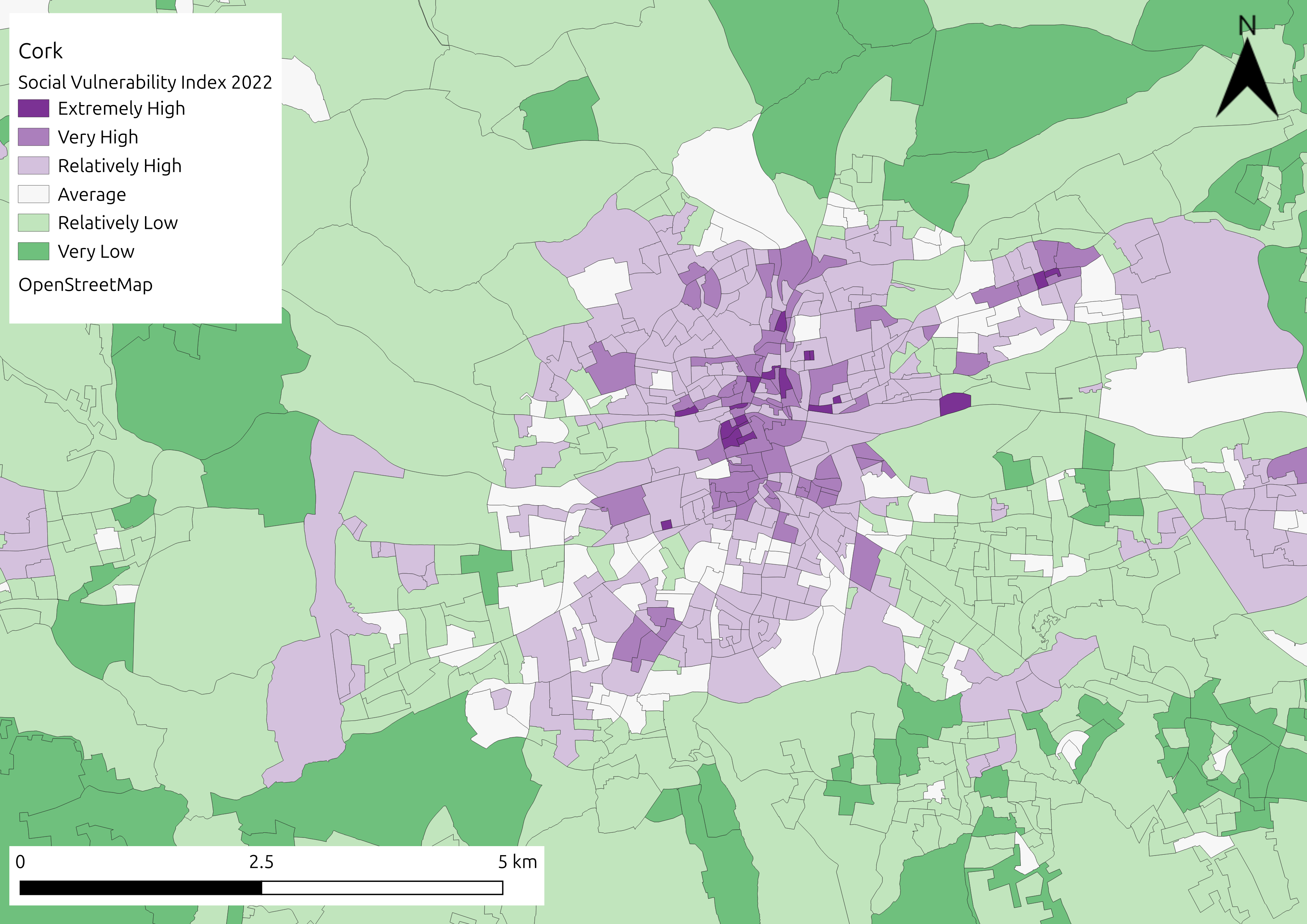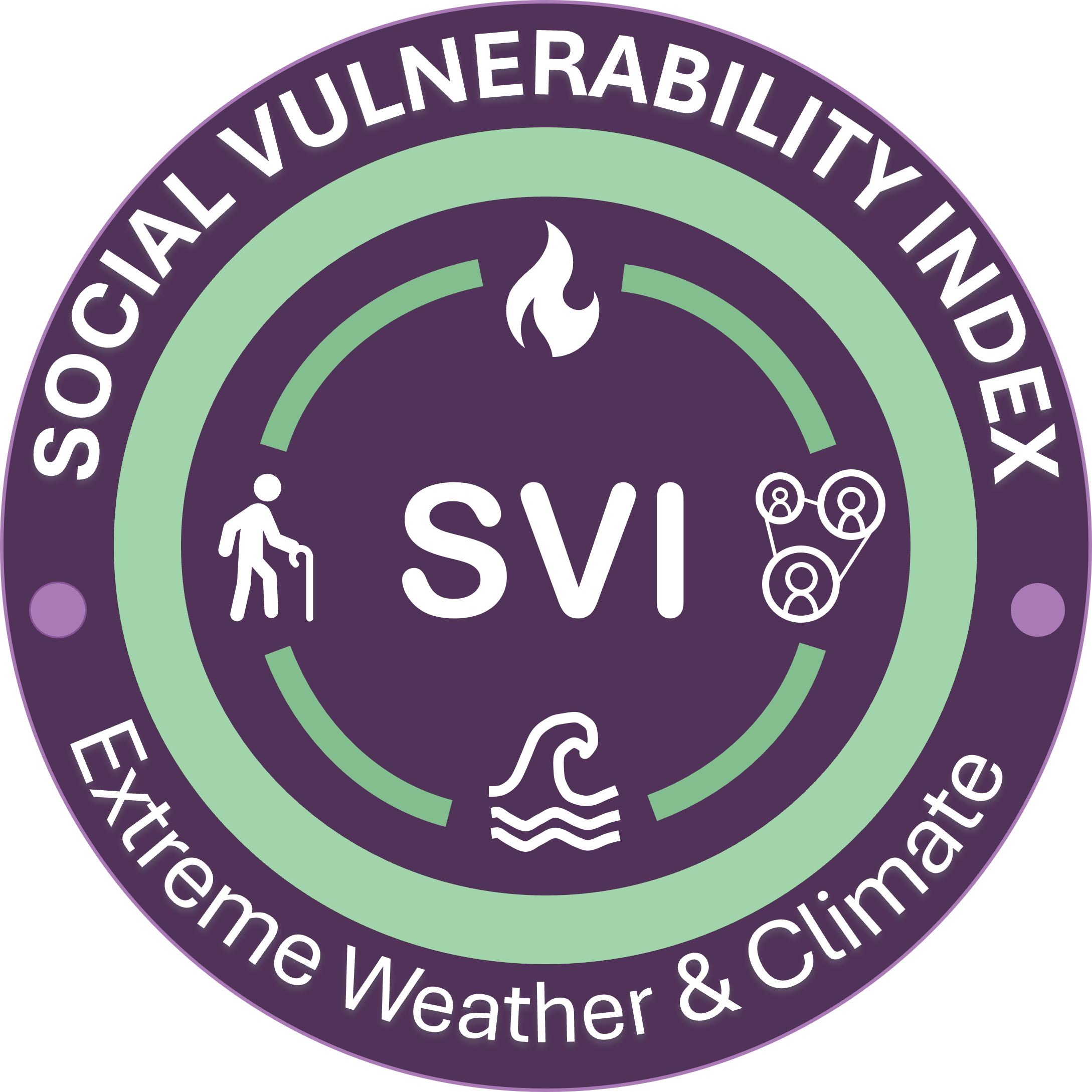Cork#
(Irish: Corcaigh [ˈkɔɾˠkəɟ]; from corcach, meaning ‘marsh’) (From Wikipedia) The second largest city in Ireland, the county town of County Cork, the largest city in the province of Munster and third largest on the island of Ireland. At the 2022 census, it had a population of 224,004.[5]
Indicators available in Cork City, Ireland to determine vulnerability to flooding (taken from the national census for Ireland and from European Copernicus datasets on land cover).
Indicator |
Domain |
Dimension |
Rationale |
|---|---|---|---|
Children under 5 years of age |
Age |
Sensitivity |
Physiologically, the young have a greater susceptibility to the effects of flooding. |
Adults over 75 years of age |
Age |
Sensitivity |
Physiologically, older people have a greater susceptibility to the effects of flooding. |
Persons with poor health |
Health |
Sensitivity |
Physiologically, those with an illness have a greater susceptibility to the effects of flooding. |
People with a disability preventing work |
Health |
Sensitivity |
Physiologically, those with a disability have a greater susceptibility to the effects of flooding. |
One parent households |
Income |
Adaptive Capacity – Ability to Prepare/Respond/Recover |
One parent households are more likely to have less disposable income compared to other households |
Children per family |
Income |
Adaptive Capacity – Ability to Prepare/Respond/Recover |
People with more dependents may struggle to respond to and recover from extreme climatic events. |
Low skilled employment |
Income |
Adaptive Capacity – Ability to Prepare/Respond/Recover |
People in low skills employment are likely to have less income, reducing their ability to adapt before, during, or after an event. |
Population employed in farming |
Income |
Adaptive Capacity – Ability to Prepare/Respond/Recover |
People who are work with farming related occupations are potentially more impacted by hazards due to the reliance upon access and quality of farmland |
Unemployment |
Income |
Adaptive Capacity – Ability to Prepare/Respond/Recover |
Unemployed persons are more likely to have less incomes, and have limited ability to make physical adjustments to their property to adapt to flooding |
Population with no higher education |
Information Access/Use |
Adaptive Capacity – Ability to Prepare/Respond/Recover |
People with limited education may find it difficult to interpret and/or act up on information received |
Population who do not speak English well or at all |
Information Access/Use |
Adaptive Capacity – Ability to Prepare/Respond/Recover |
People with poor English ability may find it difficult to interpret and/or act up on information received |
Households with no Internet |
Information Access/Use |
Adaptive Capacity – Ability to Prepare/Respond/Recover |
People with households with no internet may find it difficult to find information, pre, during, and post flooding events |
New residents |
Local Knowledge |
Adaptive Capacity – Ability to Prepare/Respond |
Residents living in the area less than a year are likely to have less local knowledge and may be less aware of hazards. |
Foreign nationals |
Local Knowledge |
Adaptive Capacity – Ability to Prepare/Respond |
Foreign nationals are likely to have less local knowledge and may be less aware of hazards. |
Households with no motor car |
Mobility |
Adaptive Capacity – Ability to Respond/Recover |
No personal access to a vehicle may restrict evacuation during a flooding event |
Travel Time |
Physical Access |
Adaptive Capacity – Ability to Respond |
People with long commutes to work/school are likely living in areas with low service provision |
Households renting |
Tenure |
Adaptive Capacity – Ability to Prepare |
Renters are more likely to have lower incomes, plus have limited ability to make physical adjustments to their property to adapt to flooding. |
Volunteering |
Social Network |
Adaptive Capacity – Ability to Respond/Recover |
Those engaged in volunteering tend to have a stronger social network that can assist them during a flooding event. |
Primary school age children |
Social Network |
Adaptive Capacity – Ability to Respond/Recover |
Those with primary school age children tend to have a stronger social network that can assist them during a flooding event. |
Households with one person |
Social Network |
Adaptive Capacity – Ability to Respond/Recover |
Those living alone likely lack a support network that can assist them during a flooding event. |
Households with no central heating |
Housing Characteristics |
Adaptive Capacity – Ability to Recover |
People that reside in households with no central heating may struggle to recover from the impacts of flooding events (cold and damp) |
Households with private water supplies |
Housing Characteristics |
Adaptive Capacity – Ability to Recover |
A private water supply may not have as sophisticated water quality monitoring as compared to the public supply, making the occurrence of water borne diseases more likely after a flooding event |
Dwelling construction year |
Housing Characteristics |
Enhanced Exposure |
Households built prior to 1945 may be of poor quality and may not offer as much protection to residents when compared to modern housing |
Households that are caravans/mobile homes |
Housing Characteristics |
Enhanced Exposure |
Caravans/mobile homes may not offer as much protection to residents as compared to permanent housing |
Unoccupied dwellings |
Housing Characteristics |
Enhanced Exposure |
Unoccupied dwellings indicate that residents are away and may prevent deployment of cautionary measures such as door guards or sandbags during a flooding event. |
Impervious surface |
Physical Environment |
Enhanced Exposure |
Increased area of impervious surface enhances the impacts of flooding |
Tree cover |
Physical Environment |
Enhanced Exposure |
Increased area of tree cover and greenspace reduces the impacts of flooding |

